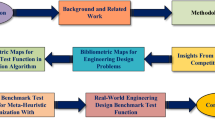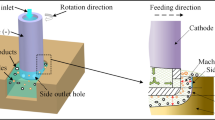Abstract
Determining the optimal process parameters and machining sequence is essential in machining process planning since they significantly affect the cost, productivity, and quality of machining operations. Process planning optimization has been widely investigated in single-tool machining operations. However, for the research reported in process planning optimization of machining operations using multiple tools simultaneously, the literature is scarce. In this paper, a novel two phase genetic algorithm (GA) is proposed to optimize, in terms of minimum completion time, the process parameters and machining sequence for two-tool parallel drilling operations with multiple blind holes distributed in a pair of parallel faces and in multiple pairs of parallel faces. In the first phase, a GA is used to determine the process parameters (i.e., drill feed and spindle speed) and machining time for each hole subject to feed, spindle speed, thrust force, torque, power, and tool life constraints. The minimum machining time is the optimization criterion. In the second phase, the GA is used to determine the machining sequence subject to hole position constraints (i.e., the distribution of the hole locations on each face is fixed). The minimum operation completion time is the optimization criterion in this phase. Simulation results are presented to demonstrate the effectiveness of the proposed algorithm in solving the process planning optimization problem for parallel drilling of blind holes on multiple parallel faces. In order to evaluate the performance of proposed algorithm, the simulation results are compared to a methodology that utilizes the exhaustive method in the first phase and a sorting algorithm.
Similar content being viewed by others
References
Agapiou J. S. (1992) The optimization of machining operations based on a combined criterion, part 1: The use of combined objectives in single pass operations. ASME Journal Engineering for Industry 114(4): 500–506
Chen M. C., Tsai D. M. (1996) A simulated annealing approach for optimization of multi-pass turning operations. International Journal of Production Research 34(10): 2803–2825
Goldberg D. E. (1989) Genetic algorithms in search, optimization, and machine learning. Addison-Wesley Longman Publishing, Inc, Reading
Gopalakrishnan, G., & Kota, S. (1998). A parallely actuated work support module for reconfigurable machining systems. In ASME design engineering technical conference, Atlanta, Georgia, September 13–16.
Gopalakrishnan V., Fedewa D., Mehrabi M. G., Kota S., Orlandea N. (2002) Parallel structures and their applications in reconfigurable machining systems. ASME Journal of Manufacturing Science and Engineering 124(2): 483–485
Ihsan S. A., Adil B., Turkay D., Huseyin F. I. (1999) Dynamic optimization of multipass milling operations via geometric programming. International Journal of Machine Tools and Manufacturing 39(2): 297–320
Kachitvichyanukul V., Sitthitham S. (2011) A two-stage genetic algorithm for multi-objective job shop scheduling problems. Journal of Intelligent Manufacturing 22(3): 355–365
Koren Y., Heisel U., Jovane F., Moriwoki T., Pritschow G., Ulosy A. G., Brussel H. (1999) Reconfigurable manufacturing systems. CIRP Annals 48(2): 1–13
Kutz, M. (2006). Mechanical engineers’ handbook, manufacturing and management, Book 3, New York: Wiley.
Levin J., Dutta D. (1992) Computer-aided process planning for parallel machines. Journal of Manufacturing Systems 11(2): 79–92
Li S. J., Li Y., Hong W. (2000) Study of multi-process tolerance synthetic optimization. Journal of Xi’an University of Technology 16(1): 88–92
Li S. J., Li Y., Liu Y. (2007) A GA-based NN approach for makespan estimation. International Journal of Applied Mathematics and Computation 185(2): 1003–1014
Mehrabi M. G., Ulsoy A. G., Koren Y. (2000) Reconfigurable manufacturing systems: Key to future manufacturing. Journal of Intelligent Manufacturing 11(4): 403–419
Mehrabi M. G., Ulsoy A. G., Koren Y., Heytler P. (2002) Trends and perspectives in flexible and reconfigurable manufacturing systems. Journal of Intelligent Manufacturing 13(2): 135–146
Moon Y., Kota S. (1998) Generalized kinematic modeling method of reconfigurable machine tools. ASME Journal of Mechanical Design 124(1): 47–51
Salehi M., Bahreininejad A. (2011) Optimization process planning using hybrid genetic algorithm and intelligent search for job shop machining. Journal of Intelligent Manufacturing 22(4): 643–652
Su C. T., Chen M. C. (1999) Computer-aided optimization of multi-pass turning operations for continuous forms on CNC Lathes. IIE Transactions 31(7): 583–596
Tang L., Landers R. G., Balakrishnan S. N. (2008) Parallel turning process parameter optimization based on a novel heuristic approach. ASME Journal of Manufacturing Science and Engineering 130(3): 031002
Tandon V., El-Mounayri H., Kishawy H. (2002) NC end milling optimization using evolutionary computation. International Journal Machine Tools and Manufacturing 42(5): 595–605
Tsai, L. W., Walsh, G. C., & Stamper, R. E. (1996). Kinematics of a novel three DOF translational platform. In IEEE international conference on robotics and automation (Vol. 4, pp. 3446–3451). Minneapolis, Minnesota, April 22–28.
Wang X. J., Da Z., Balaji A. K., Jawahir I. S. (2002) Performance-based optimal selection of cutting conditions and cutting tools in multipass turning operations using genetic algorithms. International Journal of Production Research 40(9): 2053–2065
Wick, D. (1983). Tool and manufacturing engineers handbook (Vol. 1). Dearborn, Michigan: Machining, SME.
Wilson F. W. (1963) Manufacturing Planning and estimating handbook. McGraw-Hill, New York
Yip-Hoi D., Dutta D. (1995) Data extraction from geometric models for process planning for parallel machines. Journal of Manufacturing System 14(5): 307–318
Author information
Authors and Affiliations
Corresponding author
Rights and permissions
About this article
Cite this article
Li, S., Liu, Y., Li, Y. et al. Process planning optimization for parallel drilling of blind holes using a two phase genetic algorithm. J Intell Manuf 24, 791–804 (2013). https://doi.org/10.1007/s10845-012-0628-7
Received:
Accepted:
Published:
Issue Date:
DOI: https://doi.org/10.1007/s10845-012-0628-7




